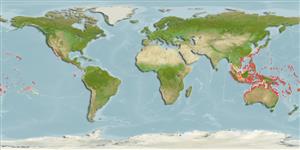Common names from other countries
>
Eupercaria/misc (Various families in series Eupercaria) >
Labridae (Wrasses) > Corinae
Etymology: Stethojulis: Greek, stetho, stethion = brest; literal = to prick a little breast + Greek, ioulis, a fish dealing with genera Coris or Thalassoma (Ref. 45335).
More on author: Bleeker.
Environment: milieu / climate zone / depth range / distribution range
Sinh thái học
Biển Cùng sống ở rạn san hô; Mức độ sâu 0 - 30 m (Ref. 9311). Tropical; 32°N - 32°S, 92°E - 89°W
Indo-Pacific: eastern Indian Ocean to western Australia, including the Christmas Island, Cocos-Keeling and the Andaman Sea; then from Japan to New South Wales, Australia. Eastern Pacific: offshore islands in the eastern Pacific, including Clipperton, Cocos and the Galapagos islands (Ref. 36378). Range extends to Baja California during El Niño (Victor, pers. comm.). Replaced by Stethojulis albovittata in the western Indian Ocean and Stethojulis balteata in the Hawaiian Islands (Ref. 37816).
Bộ gần gũi / Khối lượng (Trọng lượng) / Age
Maturity: Lm ? range ? - ? cm
Max length : 15.0 cm TL con đực/không giới tính; (Ref. 30874); 8.0 cm TL (female)
Các tia vây lưng cứng (tổng cộng) : 9; Các vây lưng mềm (tổng cộng) : 11 - 12; Tia cứng vây hậu môn: 3; Tia mềm vây hậu môn: 11. 1st spine of the anal fin is minute or imbedded (Ref. 1602).Terminal males typically have a series of partial to complete longitudinal thin blue lines on their sides (Ref. 1602). Females mainly bluish grey with fine white spotting over upper sides and a small red spot at axil of pectoral fin (Ref. 48636).
Usually found in shallow clear water of reef flats and lagoon and seaward reefs, in areas of mixed sand, rubble and coral (Ref. 9710, 58534). Usually solitary or in small groups (Ref. 9311). Feeds mainly on demersal planktonic crustaceans and small benthic invertebrates. Female length is from Ref. 9137. Replaced by S. albovittatus in the Andaman Sea (Ref. 90102). Minimum depth reported taken from Ref. 128797.
Life cycle and mating behavior
Maturities | Sự tái sinh sản | Spawnings | Egg(s) | Fecundities | Ấu trùng
Oviparous, distinct pairing during breeding (Ref. 205).
Randall, J.E., 2000. Revision of the Indo-Pacific labrid fishes of the genus Stethojulis, with descriptions of two new species. Indo-Pac. Fish. (31):42 p. (Ref. 36378)
IUCN Red List Status (Ref. 130435)
CITES (Ref. 128078)
Not Evaluated
Threat to humans
Harmless
Human uses
Các nghề cá: buôn bán nhỏ; Bể nuôi cá: Tính thương mại
Các công cụ
Special reports
Download XML
Các nguồn internet
Estimates based on models
Preferred temperature (Ref.
115969): 24.5 - 29.3, mean 28.4 (based on 2292 cells).
Phylogenetic diversity index (Ref.
82804): PD
50 = 0.5010 [Uniqueness, from 0.5 = low to 2.0 = high].
Bayesian length-weight: a=0.01000 (0.00561 - 0.01782), b=3.00 (2.85 - 3.15), in cm Total Length, based on LWR estimates for this species & Genus-body shape (Ref.
93245).
Mức dinh dưỡng (Ref.
69278): 3.2 ±0.2 se; based on diet studies.
Thích nghi nhanh (Ref.
120179): Chiêù cao, thời gian nhân đôi của chủng quần tối thiểu là dưới 15 tháng (Preliminary K or Fecundity.).
Fishing Vulnerability (Ref.
59153): Low vulnerability (10 of 100).
